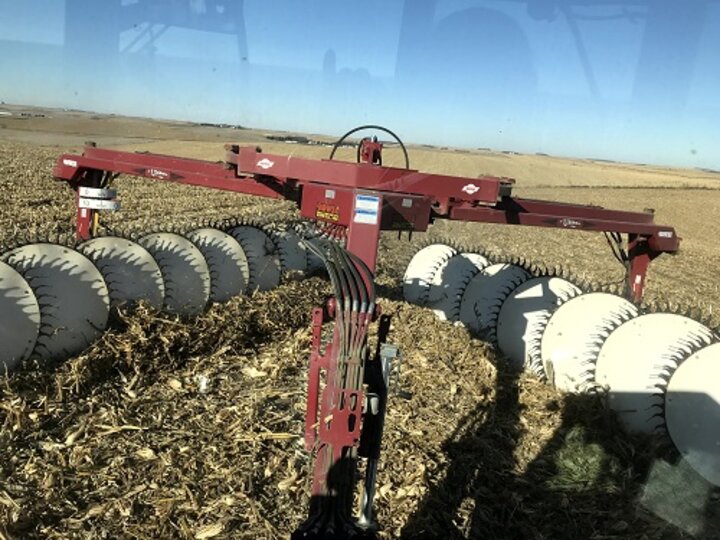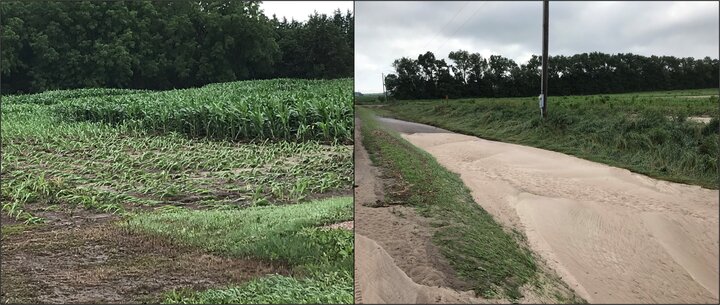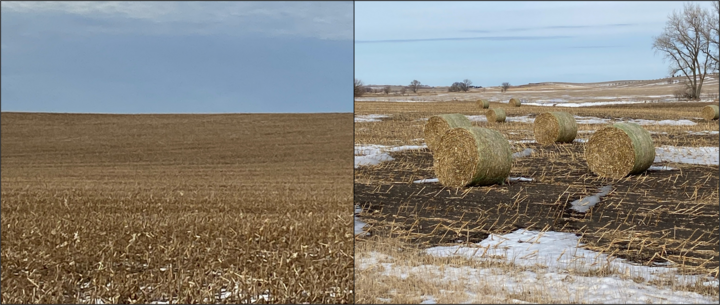Crop Residue Removal: Its Effect on Soil and Water Quality

The Role of Crop Residues
Crop residues play several important roles including:
- Protection from erosion,
- Providing nutrients,
- Improving water availability, and
- Providing shelter for wildlife and microbiology.
Crop Residues Protect Soil
One of those roles is protecting the soil from wind and water erosion. Removing crop residue exposes the soil surface to erosive forces increasing the risk of soil erosion. Most people think of water erosion, but wind erosion can be just as detrimental. This is especially true for regions with rolling hills and intense and regular wind, both of which are factors affecting soil erosion. Just this past May, a colleague and I were driving home when we encountered a massive dust storm that forced us to turn back and take shelter at a gas station until it passed. Growers can contact local NRCS offices to help them with using tools such as RUSLE2 (Revised Universal Soil Loss Equation, version 2) and WEPS (Wind Erosion Prediction System) to develop a soil conservation plan for residue removal program that leaves enough residue on the soil to reduce soil loss to a tolerable level.
Soil erosion has negative economic impact both on-site and off-site. At a farm level, impact is directly related to loss of organic matter and nutrient rich topsoil. A University of Wisconsin-Madison study indicated that eroded soil material contained 2.1 times as much organic matter, 2.7 times as much nitrogen, 3.4 times as much available phosphorus and 19.3 times as much exchangeable potassium as the bulk soil (Massey and Jackson, 1952). The moment this nutrient rich valuable soil is carried off the farm by runoff water, it will become a problem to society at large by polluting its drinking and recreational water, by filling drainage ditches and dams with sediments causing localized flooding. Governments at local, state, and federal level have to spend taxpayers’ money to clean the water and remove sediments. A 1995 study estimated the off-site cost associated with soil erosion to be 17 billion USD per year (Pimentel et al., 1995).

Crop Residues Provide Nutrients
In addition to protecting soil from the elements, crop residues also contain significant amount of nutrients. Declines in soil fertility associated with harvesting corn stover have been reported. Average nutrient concentrations are estimated to be 17 lbs N, 4 lbs P2O5, 34 lbs K2O and 3 lbs of S per ton of corn stover removed. A field that yields 150 bu per acre could produce up to 4 tons of stover. Based on current fertilizer prices and tons of corn stover removed, one can calculate the value per acre of nutrients removed. This value does not even include cost of removing the stover and the value of nutrients that may leave the field with runoff water and eroded soils. Residue removal also reduces earthworm population and microbial activities (Blanco-Canqui and Lal, 2009). Crop residues provide food to soil microorganisms that help in soil nutrient cycling.

Crop Residues Improve Water Availability
One of the limiting factors for dryland crop production is the availability of water. The impact of crop residue on soil water retention has been documented. Crop residues improve soil water storage by increasing infiltration thereby reducing runoff loss as well as evaporation loss. Crop residues, especially when left upright, also play a critical role in trapping and keeping more snow in the field. In addition to trapping snow, residues create a more uniform snow distribution resulting in a more uniform water distribution, slower surface water movement, and increased water recharge. On soybean or corn fields that have crop residues removed, snow just blows off the field and accumulates as large drifts on slopes and bottomlands where it stays longer during spring causing delays in field activities.
It may be tempting for producers to bale wheat straw and corn stover, especially in years when livestock feed or bedding is in short supply. However, crop growers should weigh all the benefits of leaving crop residue in the field against removing it. This is especially important for growers that farm dryland ground. Sustainable stover removal depends on factors such as soil erodibility, field slope, cultural practice and climatic condition of the area. In high yielding fields that are minimum till or no till, up 45% of the stover can be sustainably removed. However, other studies suggest that residue removal should be only 20-30% of the total stover production.
Corn Stover Removal: Nutrient Value of Stover and Impacts on Soil Properties 2017. UNL CropWatch
Humberto Blanco-Canqui & R. Lal (2009) Crop Residue Removal Impacts on Soil Productivity and Environmental Quality, Critical Reviews in Plant Sciences, 28:3, 139-163, DOI: 10.1080/07352680902776507
Pimentel, D., Harvey, C., Resosudarmo, P., Sinclair, K., Kurz, D., McNair, M., Crist, S., Shpritz, L., 648 Fitton, L., Saffouri, R., Blair, R. (1995). Environmental and economic costs of soil erosion and 649 conservation benefits. Science, 267(5201), 1117-1123 pp. doi:10.1126/science.267.5201.1117
Massey, H. F, Jackson, M. L. 1952. Selective Erosion of Soil Fertility Constituents. SSSA 16(4) 353-356. https://doi.org/10.2136/sssaj1952.03615995001600040008x
This article was reviewed by Ben Beckman.